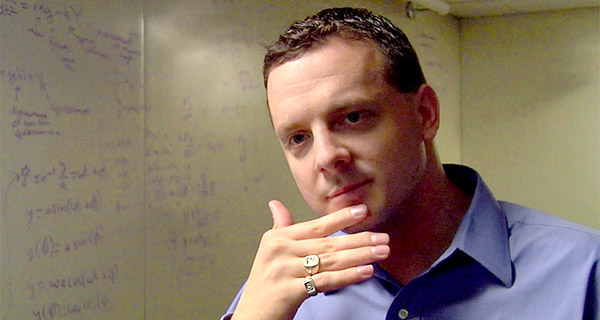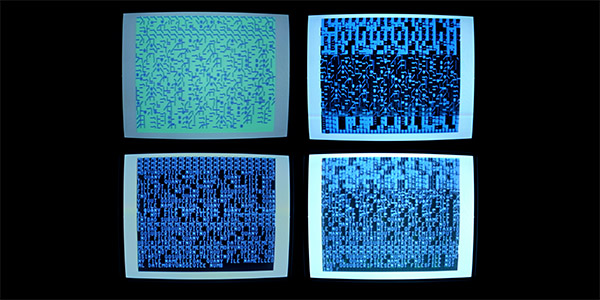ETHICS, COMPUTING AND AI: PERSPECTIVES FROM MIT
A Network of Practitioners | Nick Montfort

Nick Montfort; photo by Jason Scott
“Computing is not a single discipline or even a set of disciplines; it is a practice.”
— Nick Montfort, Professor of Digital Media
SERIES: ETHICS, COMPUTING, AND AI | PERSPECTIVES FROM MIT
Nick Montfort SM ’98, a Professor of Digital Media in the Comparative Media Studies/Writing program, develops literary generators and other computational art and poetry. Among his more than fifty digital projects are the collaborations The Deletionist and Sea and Spar Between. Much of Montfort’s work is available as free software. His publications include several books of computational poetry as well as The Future (MIT Press, 2018) and Exploratory Programming for the Arts and Humanities (MIT Press, 2016).
• • •
Q: What are some ways the MIT Schwarzman College of Computing can incorporate thinking from the humanities, arts, and social sciences?
MIT has a tremendous opportunity as it establishes the Schwarzman College of Computing: The Institute can reshape itself and help shape how the world considers computing. Entering into that goal in collegial spirit, I’d like to recommend that MIT reconsider the initial metaphors it has adopted to describe the structure of the college — in particular the metaphor of “bridge” hires, which connect a “core” (computer science and artificial intelligence) to other disciplines and areas. In this the Institute follows other universities, including Tufts, that have established computer science bridge professorships. The concept is a classic “hub and spokes” model, one way of making connections.
In newspaper headlines, when space is short, Boston is sometimes referred to as the “Hub” — originally short for the Oliver Wendell Holmes’ phrase “Hub of the Solar System,” now considered to stand for “Hub of the Universe.” Perhaps unintentionally, the College’s hub-and-spoke model, or bridge-and-core model, puts computer science in that same elevated, central place, relegating the Institute’s other academic disciplines to the periphery. Yes, computer science is indeed the discipline dedicated to advancing our understanding of computing itself. Yes, it’s better to offer to build bridges than not. Nevertheless, there is an important problem with making computer science central, or “core,” to computing in this way: Computing is not a single discipline or even a set of disciplines; it is a practice.
Practitioners
Consider the Media Lab, which is sometimes called “anti-disciplinary” yet has certainly made considerable advances in computing. There is no contradiction in this: Researchers at the Media Lab are serious practitioners of computing. They advance computing by developing projects that can be demonstrated and critiqued; their work draws on, but is not limited to, concepts in architecture and design. They do not need to be disciplinary computer scientists, or disciplinary at all, to be important practitioners of computing.
Practitioners are developing many important new insights into computing — computer scientists are, of course, but also those in computational linguistics, computational economics, computational biology, computational musicology, the digital humanities more broadly, computational media, and algorithmic art of all sorts: visual, literary, sonic, and so on.

Screen images from Nick Montfort’s Traumaphore (2017), a 64-byte Commodore 64 program written in 6502 assembly. The progam features graphical and sound effects, and generates text using a bigram, per-character Markov chain, with the table of BASIC error messages from the Commodore 64’s ROM used as data.
"The new college presents an opportunity for many practitioners of computing at MIT. We should use this chance to build a truly robust network and to make many relevant types of connections."
— Nick Montfort, Professor of Digital Media
Making connections
If we take the bridge and core metaphor seriously, it means that from each island of computation we must travel to the core and on from there, as if we all needed to fly through Atlanta to get anywhere else from Boston. Why? Research in computational linguistics is certainly relevant to literary studies in the digital humanities. Those using computing to study narrative will engage in both. Shouldn’t researchers be able to connect those two fields directly? Shouldn’t they be encouraged to do so structurally, by “network hires” rather than by only hiring those who do computer science and something else?
That is, couldn’t we hire people who connect different computing practices, but may not be computer scientists — a faculty member who deals with musical and visual programming in performance (livecoding), for instance, or one who does digital humanities work on cultural corpora of both images and texts?
In my teaching, research, and artistic practice, I seek to expand people’s ability to create and inquire using computing. I develop poetry in the form of text-generating computer programs — all of which I release as free/open-source software, and which people are therefore welcome to study, modify, and even use as the basis for their own projects. These are small-scale systems, meant to be inviting. Many have started their exploration of programming by modifying my one-page poem and program Taroko Gorge. This program outputs text boundlessly according to rules that can be discerned in the code itself.
Computational media and arts
Taroko Gorge is a minimal system, but one thing it has in common with Red Dead Redemption II, a videogame that is a million times more complex, is that neither one is well-understood as an example of computer science, or even as simply the application of computer science. They are both much better understood as examples of digital media or art, or as computational media or art. Whatever we call it, this is an important area of study and practice that is deeply engaged with computing. And those working with computing today in the visual arts, music, the literary arts, and gaming should be able to connect without intermediaries.
To advance my goals as a teacher, I wrote Exploratory Programming for the Arts and Humanities (MIT Press, 2016) and am now developing a second edition. My book is about how programming (the most general way of dealing with computation) can help artists generate new sorts of work and can help humanists conduct new sorts of studies, building upon existing humanistic methods and artistic practices. Some who start with this book might possibly go on to become computer scientists, but the book is not a course in computer science. I developed it to bring both artists and humanists to computing on their own terms.
The new college presents an opportunity for many practitioners of computing at MIT. We should use this chance to build a truly robust network and to make many relevant types of connections, not all of them through a single core.
Suggested links
Series:
Ethics, Computing, and AI | Perspectives from MIT
Nick Montfort:
Website
Webpage at Comparative Media Studies / Writing
The Future (MIT Press, 2018) and other publications
MIT Program in Comparative Media Studies / Writing
Stories:
3 Questions: Nick Montfort on shaping the future
New book delves into “future-making” as a noble endeavor.
Life in BASIC
Nick Montfort and colleagues examine cultural significance of computer code in new book.
Celebrating the "Pleasures of Poetry" at MIT
Ethics, Computing and AI series prepared by MIT SHASS Communications
Office of Dean Melissa Nobles
MIT School of Humanities, Arts, and Social Sciences
Series Editor and Designer: Emily Hiestand, Communication Director
Series Co-Editor: Kathryn O'Neill, Assoc News Manager, SHASS Communications
Published 18 February 2019